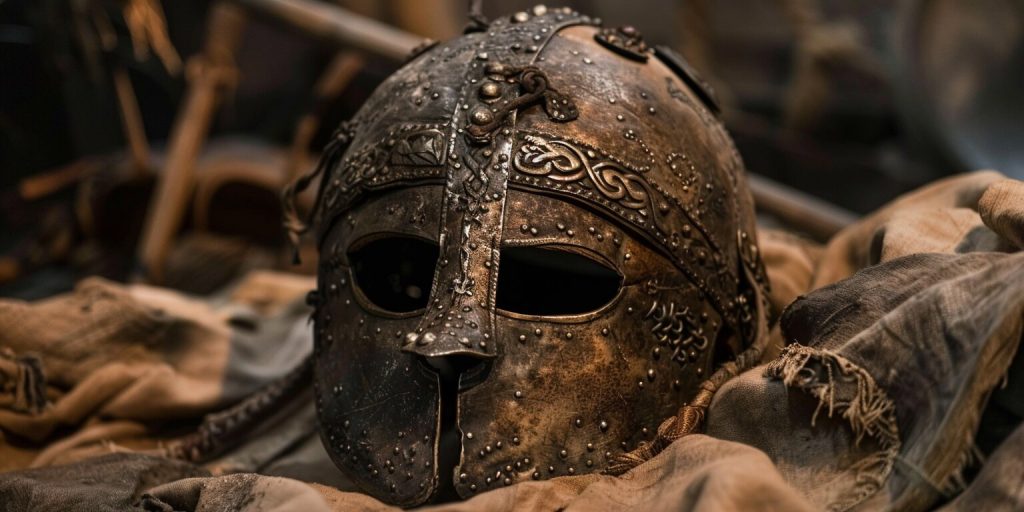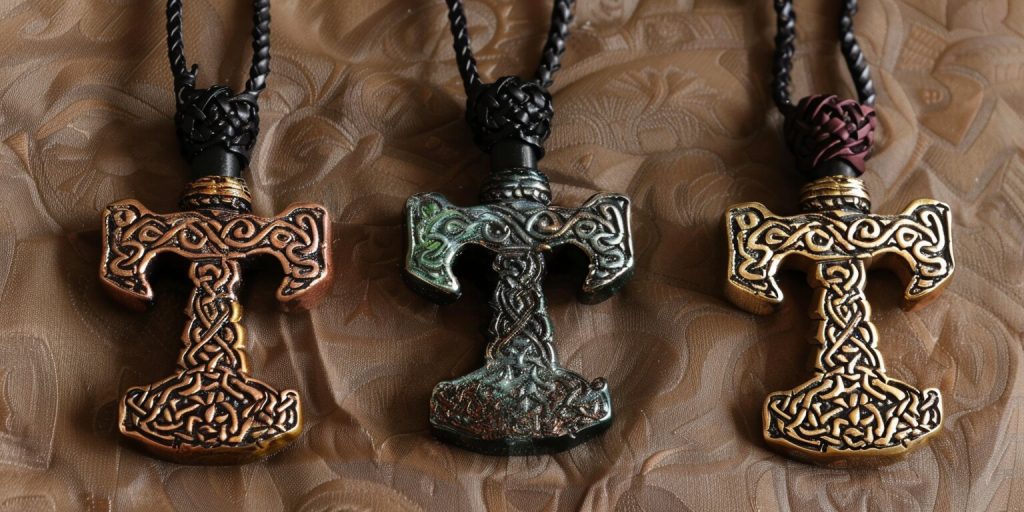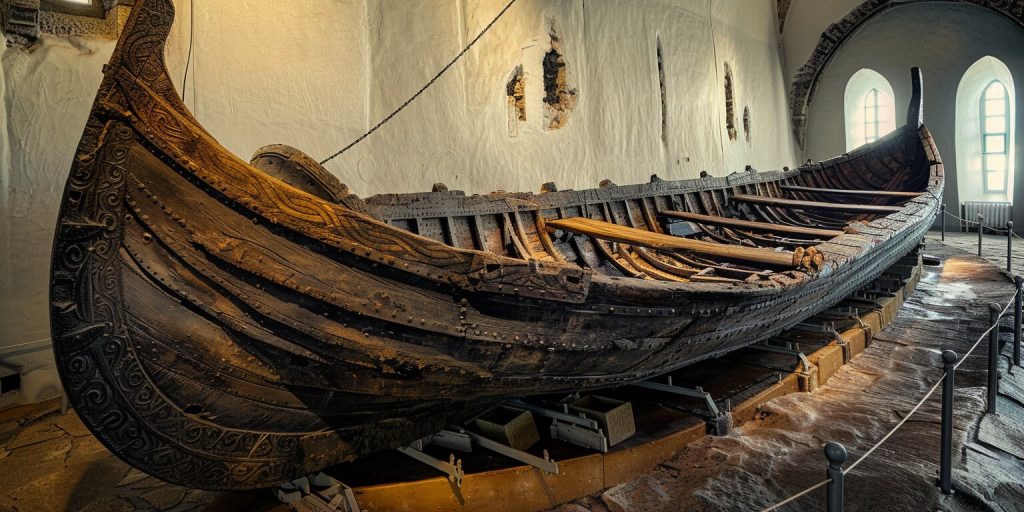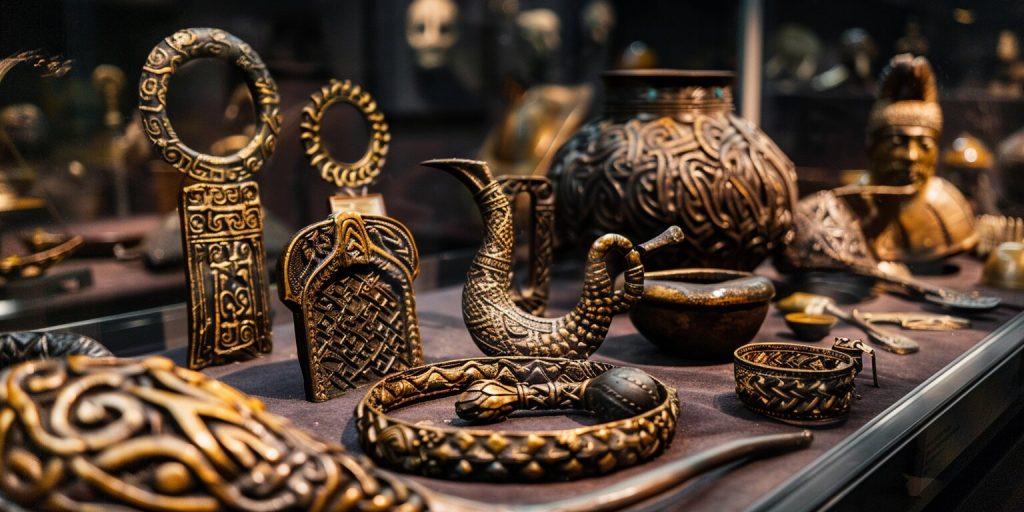Viking Heritage, Viking Ships, Viking Sites, Viking Weapons and Armor, Vikings
Top 10 Viking Artifacts Ever Found
The allure of Viking artifacts captivates historians and enthusiasts alike. They offer a fascinating glimpse into the lives of the ancient Norse people. These artifacts reveal stories of culture, craftsmanship, and daily life, such as the use of Viking silver.
From tools to jewelry, famous Viking artifacts unlock a window to a rich heritage shaped by exploration and adventure. Let’s explore the ten most significant artifacts ever uncovered. They shed light on their historical importance and the enduring legacy of Viking civilization.
Introduction to Viking Artifacts
Real Viking artifacts offer a peek into the past, from around 793 to 1066 AD. They connect us to ancient Norse culture and tell us about the Vikings’ daily lives.
The collection includes everything from jewelry to weapons. Each piece shows the high skill of the Viking craftsmen and tells us about their society, trade, and spiritual beliefs.
Archaeology has uncovered many viking artifacts. These finds show the skill of the artisans and how Vikings interacted with others. Archaeologists use these discoveries to learn more about Viking history.
What Are Viking Artifacts?
Viking artifacts, ranging from daily items to ceremonial pieces, are key to understanding Viking culture. These objects show us the beliefs, practices, and lives of the Vikings. They are important for their beauty and the stories they tell about Viking society and trade.
Understanding the Importance of Artifacts in Viking Culture
Viking artifacts are more than just pretty objects; they include pieces like the Viking helmet. They give us clues about the Vikings’ spiritual beliefs, trade, and art. Historians learn about Viking life and culture by studying these artifacts, including information on Viking raiders. They help us see how the Vikings lived and interacted with each other and their world.
Key Characteristics of Authentic Viking Artifacts
Authentic Viking artifacts stand out with certain features, such as Viking silver and Viking helmet designs. These include:
- High-quality materials like iron for weapons and gold for jewelry.
- Intricate metalwork that shows the skill of the artisans.
- Runic inscriptions tell us about their importance.
- Design motifs that reflect the art of that time.
Visiting museums like the British Museum lets us see the skill of Viking creators. Each artifact adds to our understanding of Viking culture. It shows why these artifacts are so important in history and today.
The Significance of Viking Archaeology Finds
Viking archaeology opens a window to the past, showing us the details of the Viking Age. Researchers find sites that tell us about settlement, trade, and daily life through excavation. These artifacts add to our understanding of history and give us a peek into Viking culture, including the craftsmanship of Viking silver.
How Excavations Unveil Viking History
Excavations in different places have found important Viking artifacts across Europe. Each site gives us clues about the Vikings’ lives, beliefs, and how they interacted with their world. Finding structures, tools, and burial sites helps us understand historical times that were once a mystery.
Major Viking Archaeological Sites
Some Viking archaeological sites are key to understanding the era. Important places include:
- Birka, Sweden – A key trading center with many artifacts related to commerce.
- Oseberg ship burial, Norway – A unique site with many Viking artifacts found in a well-preserved ship.
- Coppergate excavations, York, England – Showing Viking settlement in England with domestic items and tools.
These sites have taught scholars about Viking expansion, trade paths, and interactions with other cultures. They link us to a captivating historical time, including the era of Thor and the largest Viking ship ever found.
Famous Viking Artifacts Throughout History
Over the years, many famous Viking artifacts have been found. These discoveries have changed how we see Viking civilization and its role in history and caught the attention of historians and fans.
Notable Finds and Their Impact on Modern Understanding
The Gjermundbu helmet is one of the oldest viking artifacts found. It shows the skill of Viking blacksmiths. Found in Norway, it tells us about Viking warfare and culture.

Another important find is the Viking hoard from the Isle of Lewis. It includes beautiful gold and silver jewelry, showing that Vikings were warriors and skilled artisans.
Artifacts That Sparked Global Interest
Many ancient Norse artifacts found in England have interested people worldwide in Viking culture. Things like Thor’s hammer pendants and beautiful jewelry show their spiritual beliefs and skill. These items have changed how people see the Vikings, proving they were more than just warriors.
Top 10 Viking Artifacts Ever Found
The discovery of Viking artifacts tells us about a civilization full of culture and skill. These artifacts show us the Vikings’ talents in trade, war, and everyday life. Here, we’ll look at ten of the most important Viking artifacts found, highlighting their historical value and significance.
A Brief Overview of Each Artifact
These top ancient Viking artifacts shine a light on different parts of Viking society. Some examples include:
- The Gokstad ship is a burial vessel that shows Viking sailing skills.
- The Oseberg ship is famous for its detailed carvings and rich finds.
- The Lofotr Viking Museum’s items tell us about Viking feasting and community.
- Various weapons from battle sites show Viking fighting skills.
- Beautiful jewelry showing Viking artistry and personal style.
Criteria for Selection of the Top 10
Choosing the best Viking artifacts is important. We look at several factors:
- Historical significance: These artifacts give us a peek into Viking life and culture.
- Uniqueness: Items must be special because of their design, making, or rarity.
- Archaeological impact: Artifacts that have greatly helped us understand Viking history are chosen.
- Diversity: We pick a mix of categories to give a full view of Viking life.
This list of artifacts shows the most important Viking finds and shares the spirit of a culture that has intrigued people for centuries.
Viking Artifacts Found in England
England is a key spot for finding ancient Norse artifacts. Places like York and the Hebrides have shown us a lot about Viking life and culture. Finds like the Cuerdale hoard show how much Vikings influenced England and how they mixed with Anglo-Saxon people.
Significant Discoveries and Their Locations
Many Viking artifacts found in England show deep links between the two cultures. Notable finds include:
- The Cuerdale Hoard is a collection of silver ingots and coins found in Lancashire.
- Items from the Jorvik Viking Centre show the rich culture of Viking York.
- Various personal items found in London show trade and daily life.
Connections to Anglo-Saxon History
The Viking artifacts found in England tell us a lot about Anglo-Saxon history. They show how Vikings traded, fought, and shared culture with local people. These items are proof of historical changes and help us understand the time better.
Rare and Unique Viking Artifacts
Viking culture left behind many artifacts, some very rare and unique. These artifacts show the Vikings’ skills and tell us about their beliefs and society.
Exploring Incredibly Rare Viking Finds
The Mjölnir amulets are rare Viking artifacts that show the Vikings’ deep connection to Norse mythology. Each find, like weapons and tools, helps us understand Viking life and how they lived together.

What Makes Them Unique?
These artifacts are special because of their craftsmanship, materials, and inscriptions. They often have unique designs or use rare materials. This makes them stand out and adds to their historical value.
Viking Artifacts: Jewelry and Amulets
Viking jewelry shows a deep tradition and rich symbolism. These items were more than just pretty things. They told stories of who the wearer was, what they believed, and their place in society.
Symbolism Behind Viking Jewelry
Viking jewelry was often linked to family or protective spirits. Brooches and rings showed one’s status and faith. Their detailed designs and materials tell us about the beliefs that shaped Viking culture, helping us appreciate the art and values of the Viking people.
Popular Types of Viking Amulets
Viking amulets were very meaningful. Here are some examples:
- Thor’s Hammer (Mjölnir): A symbol of protection worn to call upon Thor’s strength and keep the wearer safe.
- Yin-Yang Symbols: These showed the balance and duality of life, reflecting deep Norse spiritual thoughts.
- Wolf and Bear Symbols: Linked to power and wildness, these amulets connected the wearer to nature and their heritage.
Today, Viking amulets still hold deep meaning. Many were found with people when they were buried, showing their role in protecting the wearer. This highlights the spiritual side of Viking life.
Weaponry and Tools as Viking Artifacts
Exploring Viking weaponry gives us a peek into their combat and daily lives. These tools show their values and the importance of warfare in their society. They help us understand their military skills and craftsmanship and how they organized their society, much like the Viking warriors whose stories captivate us.
Insights Into Viking Combat and Daily Life
Vikings used swords, axes, and shields for various tasks. These tools were not just for fighting; they also had roles in everyday life and were symbols of status. The designs on many blades show the art in their tools.
This shows how Vikings combined practicality with craftsmanship in their weapons. It highlights their approach to both war and making things.
Noteworthy Weapon Finds
Important finds like the Uppsala sword give us clues about Viking combat, society, and the role of the Viking warrior. Finds like spearheads and arrowheads show their advanced military tech and trade links. These items tell us about their trade and social structure.
They also show us their connections with other cultures, including those found in Britain, which adds to our knowledge of the Viking world.
Secrets of Viking Burial Sites
Exploring Viking burial sites reveals the deep traditions and beliefs of the Viking culture. Ship burials were especially important. They honored the dead and showed their status. They also helped the deceased on their journey to the afterlife.
The Role of Ship Burials in Viking Culture
Ship burials were key in Viking culture. They were complex rituals that showed the wealth and social rank of the dead. The ships were seen as vessels to carry souls across mythical seas.

Excavations at sites like the Oseberg burial have uncovered detailed customs, including offerings and personal items. These help us understand Viking beliefs about death and the afterlife.
Artifacts Discovered Within Burial Mounds
Artifacts found in burial mounds are vital to understanding Viking heritage. These include tools, weapons, and jewelry, which show the values and daily lives of the buried.
Each artifact tells us more about Viking society. It highlights their craftsmanship and social ties. By studying these items, researchers learn about Viking death customs and beliefs.
The Impact of Viking Artifacts on Modern Culture
Today, ancient Viking artifacts have a big impact on our culture. They grabbed the attention of historians and the public alike, leading to a strong interest in the Vikings that goes beyond school subjects.
Media like movies, TV shows, and books bring Viking life to life, featuring elements like the Viking warrior and raider. They mix real history with stories that capture our imaginations.
Many stories make the Viking Age seem exciting and full of bravery. This has made more people want to learn about their Viking roots.
Viking designs even show up in today’s fashion. Designers use the patterns from Viking jewelry and weapons in their clothes. This shows how old ideas still influence what we wear.
These stories and designs make people excited about Norse history. But it’s important to remember that Viking life was complex. We need to balance the fun stories with the real history of the Viking raiders.
This mix of old and new keeps the Vikings’ story alive and interesting for today’s people.
Conclusion
The journey through the world of Viking artifacts has given us a deep look into Viking culture and history. Each artifact shares a story, showing us the Vikings’ daily lives, art, beliefs, and complex society. These relics, from jewelry to weapons, tell us a lot about the people who lived in the North.
This overview of Viking artifacts shows why archaeologists are still important. They help us see the Viking Age in a new light and its effect on today’s world. These artifacts connect us to the past, keeping alive the legacy of a culture that still influences us.
Studying Viking artifacts helps us better understand history. It lets us see the art and creativity of a people whose impact is still felt today. As we learn more about their achievements, we honor the Vikings and the stories their artifacts tell.

